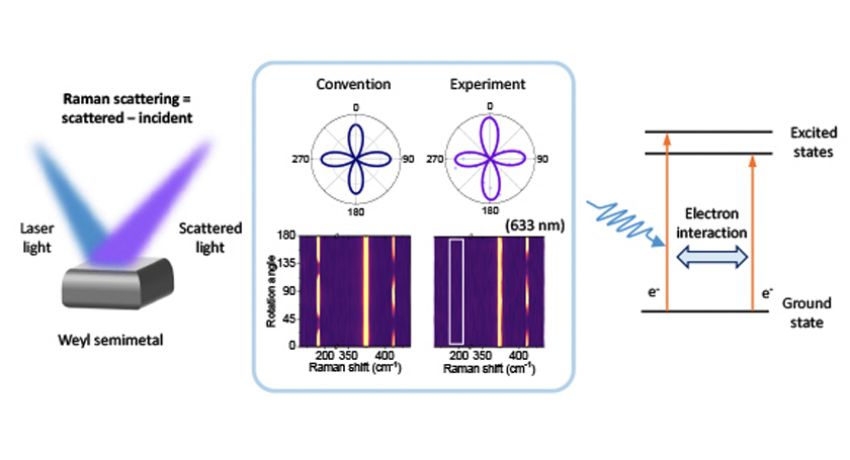In the middle is the observed broken symmetry in Weyl semimetal. Illustration of Raman scattering (left) and electrons jumping to two close higher bands (right). Image: Shenxi Huang, Penn State
By Walt Mills
A method to observe a new class of topological materials, called Weyl semimetals, was developed by researchers at Penn State, MIT, Tohoku University, Japan and the Indonesian Institute of Sciences. The material’s unusual electronic properties could be useful in future electronics and in quantum physics.
“Weyl semimetals are interesting because their electron transport shows some unusual behavior,” says Shengxi Huang, assistant professor of electrical engineering, Penn State. “For example, they can show negative magnetoresistance, which means when you apply a magnetic field, the resistance drops. With many conventional materials, it increases.”
In Weyl semimetals, the electronic band structure is different from normal. The electrons have chirality, meaning "handedness." The chirality is connected to the electrons’ spin and traveling direction. Electrons with left chirality travel in the opposite direction of its spin, while electrons with right chirality travel in the same direction of its spin.
“Normally, a material would have some kind of conservation, for example, charge neutrality conservation — meaning if you had a certain number of negative charges you would have the same number of positive charges,” according to Kunyan Zhang, Huang’s graduate student and lead author on a paper in the journal Physical Review B. “Similarly, you would also normally have the same number of righthanded electrons as lefthanded ones. But this is not the case in this material and that seems to boost new electron transport properties.”
The team decided to use light to study the peculiar behavior of the electrons because it is simple to use and easier than building sophisticated devices. The light interacts with the electrons and also with the lattice, causing the atoms to vibrate, creating phonons. The phonons and electrons interact and the Raman signals — the difference between the laser and scattered light — can show the unusual behavior of the electrons.
The main result of the researchers' work is to show that the material’s symmetry is broken. In principle, this crystalline material should have four-fold symmetry, which means that when the crystal is rotated 90 degrees the property is exactly the same. However, in this study, if the Weyl semimetal is rotated 90 degrees, there is a deviation from symmetry.
In addition, this material should show three peaks in the Raman spectrum, but in one 633-nanometer — red — light excitation one peak is missing. That is peculiar, according to the researchers. The explanation lies in the band structure of Weyl semimetal. When electrons interact with light, they absorb enough energy to jump to a higher state. In Weyl semimetals, there are many higher states very close to each other. The interaction between the electrons jumping to two adjacent bands can break symmetry.
In this type of material, the electrons can flow without any back scattering under certain conditions, making it a good platform for future electronics. There is also a connection to quantum computing, since a material that does not scatter has the potential to be used in quantum qubits.
“We provide the community with a simple method to understand this material’s electronic behavior,” Huang concluded. “And this method can be generalized.”
Next up, the team will attempt to study phonon/electron interactions at a reduced temperature, under 10 Kelvin, where the behavior should be quite different.
Additional authors on the paper, “Anomalous phonon-mode dependence in polarized Raman spectroscopy of the topological Weyl semimetal TaP,” are Xiaoqi Pang, Tong Wang, Nguyen Hung and Riichiro Saito, all of Tohoku University, Japan; Fei Han and Mingda Li of MIT; Ahmad Nugraha of Indonesian Institute of Sciences and Tohoku University; and Shun-li Shang and Zi-Kui Liu, Penn State.
The U.S. Department of Energy supported this work. Raman spectroscopy was performed in the Materials Characterization Lab at Penn State.
Read the full news story here:
https://news.psu.edu/story/607876/2020/02/11/research/new-class-materials-sho...

